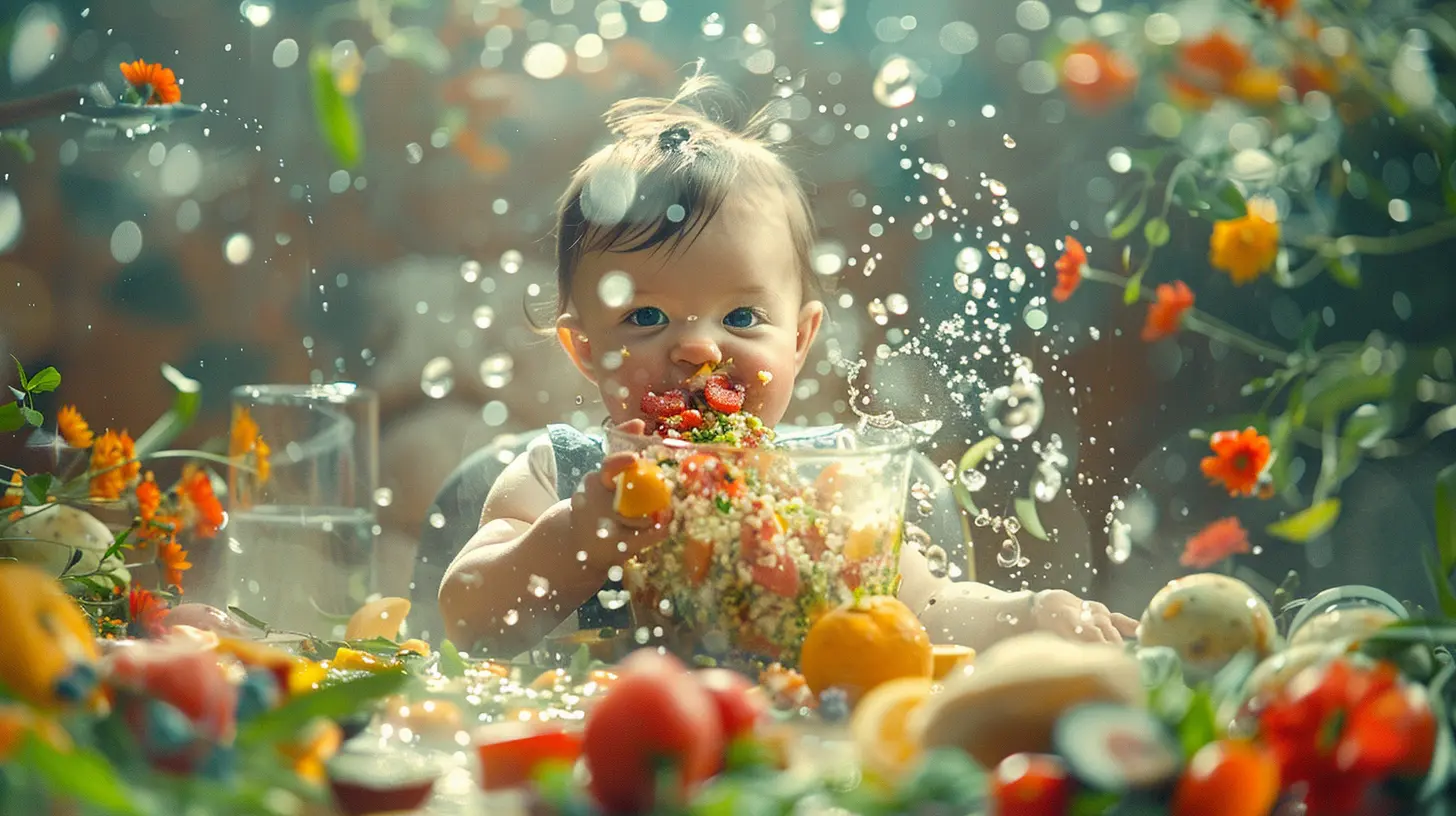Introducing Solids: A Key Stage in Baby Development
27 September 2025
So, your little bundle of joy is starting to drool at the sight of your dinner plate? That’s a pretty good sign it might be time for the next big milestone—introducing solids! Starting solids is one of the most exciting (and sometimes nerve-wracking) stages in a baby’s development. You’re not just feeding them; you’re helping to shape their future tastes, preferences, and even their eating habits.
But here’s the thing: introducing solids can feel overwhelming—purees or baby-led weaning, what foods first, how much, when? Deep breath, mama (or papa), we’ve got you. This guide is going to walk you through it all in a way that’s down-to-earth and easy to digest—kind of like mashed bananas.
Let's dive in.
Why Introducing Solids Is Such a Big Deal
You might wonder, “Why all the fuss over a spoonful of mush?” Well, starting solids isn’t just about nutrition—it’s also about development. Around the 6-month mark, babies begin to need more than just breast milk or formula to meet their growing nutritional needs, especially for iron and zinc. But there’s more to it than nutrients.Introducing solids helps:
- Develop motor skills (hello, hand-eye coordination!)
- Build oral motor strength (which helps with speech later on)
- Set the foundation for lifelong eating habits
- Encourage family mealtimes and social connection
So yeah, it’s kind of a big deal. 
When Is the Right Time to Introduce Solids?
Now, every baby is different, but most experts (including the World Health Organization and American Academy of Pediatrics) recommend starting solids around 6 months of age. Some signs your baby might be ready include:- Sitting up with little or no support
- Good head and neck control
- Showing interest in food (a.k.a. stealing your fork)
- The tongue-thrust reflex (that thing that pushes food out) has faded
- They can open their mouth when food approaches
One thing to remember: age is just a number. Look for those readiness cues rather than rushing the calendar.
Purees vs. Baby-Led Weaning: What’s the Best Approach?
Ah yes, the age-old debate: smooth and spoon-fed or chunky and self-fed? Let’s break it down:Purees
This is the traditional route. You start with smooth-textured foods (like mashed sweet potato or apple puree) and gradually build up to thicker textures and small chunks.Pros:
- Easier to keep track of how much baby is eating
- Minimizes gagging and choking risks early on
- Ideal for babies who might have feeding difficulties
Cons:
- More spoon-feeding means less independence for baby
- Transitioning to textures later can be a sticky situation (literally and figuratively)
Baby-Led Weaning (BLW)
This method skips purees altogether. You offer baby soft, graspable food from the start—think avocado slices, banana spears, or roasted veggie sticks—and let them explore eating at their own pace.Pros:
- Fosters independence and self-regulation
- Encourages family meals (baby eats what you eat)
- May reduce picky eating later on
Cons:
- Messier (like, you-might-need-a-hazmat-suit messier)
- Increased anxiety around choking (note: gagging is normal and different from choking)
Still not sure? You don’t have to choose just one method. Many parents go with a combination approach—starting with purees and gradually incorporating finger foods.
Best First Foods for Baby
When you’re standing in the baby food aisle staring blankly at all those jars and pouches, here’s a simple truth: babies don’t need fancy blends to start. Some of the best first foods are basic, whole, and packed with nutrients.Iron-Rich Options
Iron is huge at this stage. Babies are born with a natural supply, but it starts to run low around six months. So starting with iron-rich foods gives them a solid nutritional boost.- Iron-fortified cereals
- Pureed or finely minced meat (yes, babies can have meat!)
- Lentils and beans
- Tofu
Fruits & Veggies
Introduce a rainbow! Not just for the nutrients, but to help baby get used to different colors, textures, and tastes.- Avocado (creamy, full of good fats)
- Sweet potato (soft, sweet, and easy to mash)
- Carrots, peas, zucchini
- Apples, pears, and bananas (start cooked or mashed)
Allergen Introduction
It used to be one food at a time and avoid allergens early. But times have changed. Research now shows introducing allergens like peanuts, eggs, dairy, or wheat early on (around 6 months) can actually help prevent allergies.The key? Introduce one allergenic food at a time, watch for any reaction over 2–3 days, and then move on to the next.
How to Feed: Tips for a Smooth First Bite
Now that you know when and what, let’s talk about the how. Because trust me, the how can be the difference between a peaceful mealtime and a food fight.1. Chill on the Pressure
Babies are natural-born eaters—but also natural-born mess-makers. Don’t stress if they only take a bite or two in the beginning. Solid feeding is just as much about learning as it is about eating.2. Start Once a Day
Begin with one small "meal" a day when baby is alert and happy (not grumpy or overtired). Breakfast or lunch is often best because if there's any reaction, you'll spot it during the day.3. Let Baby Lead
Even with spoon-feeding, you can let your baby guide you. If they lean in, great. If they turn their head away—respect it. You’re building a relationship with food, not just filling a tummy.4. Expect the Mess
Think of that mess as sensory play. Food on their hands, in their hair, maybe even on the walls—it’s all part of the process. A good bib and some floor protection go a long way.Common Concerns (and What to Do About Them)
What if my baby gags?
Totally normal. Gagging is a safety mechanism. Choking, on the other hand, is rare but serious. Always supervise meals, avoid hard/raw foods (like whole grapes or nuts), and learn infant CPR—it’s a smart move for every parent.Is my baby eating enough?
For the first few months, solids are more like a side dish. Breast milk or formula should still be the main source of nutrition until at least 12 months. Let baby’s cues be your guide—full babies turn away, close their mouths, or get fidgety.My baby hates veggies—what now?
Don’t give up! It can take 10 or more tries for a baby to accept a new taste. Keep offering, switch up preparations, and try not to react too much. You want mealtime to stay a positive experience.The Journey Continues: What Comes After the First Bite?
Once your baby is rocking those single-ingredient purees or soft finger foods, it’s time to:- Increase variety: Mix different foods, explore herbs and spices (skip the salt and sugar for now)
- Work on textures: Move from smooth to mashed, to lumpy, to soft pieces. Texture progression is key for oral development
- Include family meals: Let baby join you at the table and eat modified versions of what you’re having
By around 9–12 months, babies should be eating a variety of foods from all food groups and gradually moving toward three meals a day plus snacks.
Final Thoughts: Keep It Real (And Fun)
Introducing solids is equal parts joy and chaos. Some days, your baby will gobble up everything in sight. Other days, they’ll throw oatmeal at your cat. That’s okay. This journey isn’t just about food—it’s about connection, curiosity, and building healthy habits that’ll last a lifetime.So grab that spoon (or avocado wedge), keep your phone ready for those messy-face pics, and trust your baby—and yourself.
You’ve got this.
all images in this post were generated using AI tools
Category:
Infant DevelopmentAuthor:

Maya Underwood
Discussion
rate this article
1 comments
Sloan Meyers
Introducing solids? More like unleashing a mini tornado in your kitchen! With purees flying and tiny taste buds exploring, it’s not just about food; it’s about survival. Buckle up, parents—your culinary adventure has just begun, and chaos is the secret ingredient!
October 4, 2025 at 4:26 AM

Maya Underwood
Absolutely! Introducing solids can be a wild ride, but it's an essential part of exploration and growth for both baby and parents. Embrace the chaos—it's all part of the adventure!


